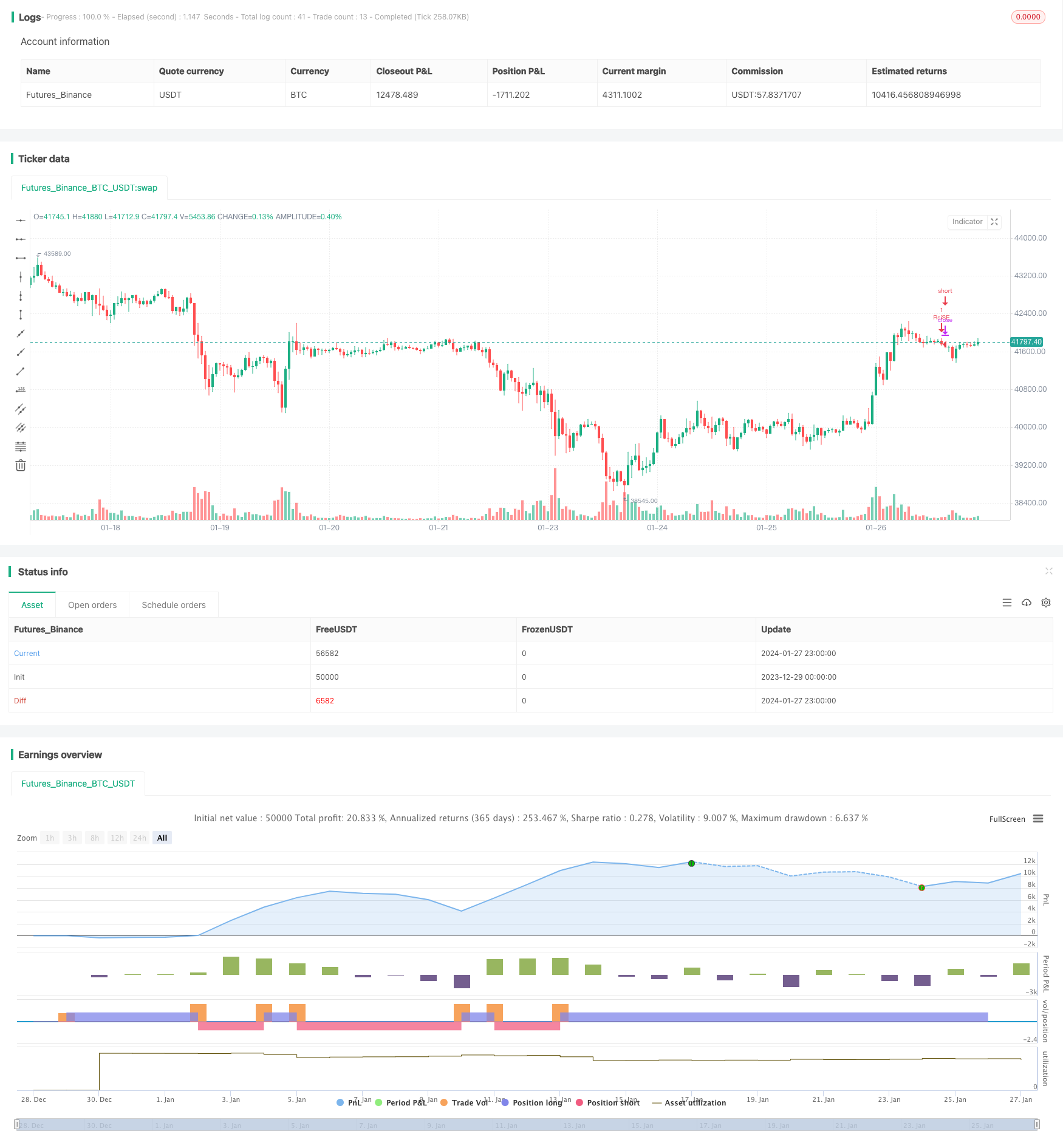Name
基于RSI的止损止盈策略RSI-based-Stop-Loss-and-Take-Profit-Strategy
Author
ChaoZhang
Strategy Description
本策略基于相对强弱指数(RSI)指标设计了一个自动设置止损止盈的交易策略。当RSI指标超过设定的过买线或超过设定的过卖线时,策略会分别开仓做多头或空头。同时,策略会根据开仓价格和设定的止损比例及止盈比例自动设置止损价位和止盈价位。
本策略使用RSI指标判断市场的超买超卖现象。当RSI指标低于设定的低点(默认为30)时,认为市场处于超卖状态,此时做多;当RSI指标高于设定的高点(默认为70)时,认为市场处于超买状态,此时做空。
做多做空后,策略会根据止损比例(默认为5%)和止盈比例(默认为10%)自动设置止损价位和止盈价位。例如,做多后,止损价位为开仓价格的(1 - 止损比例),止盈价格为开仓价格的(1 + 止盈比例)。
本策略最大的优势在于可以自动设置止损和止盈,降低交易风险。止损可以减少亏损,止盈可以锁定利润。同时,相对强弱指数是一项成熟的技术指标,可以较好地判断市场是否处于超买或超卖状态。
本策略也存在一定风险。RSI指标可能发出错误信号,导致不必要的亏损。此外,止损或止盈被触发也可能使利润损失一部分。设置止损止盈比例需要谨慎,过于宽松可能无法有效控制风险,过于激进可能造成不必要的止损。
可以通过优化RSI参数或调整止损止盈来降低这些风险。另外,本策略也可结合其他指标来验证信号,提高决策的准确性。
本策略可从以下几个方面进行优化:
-
优化RSI参数,寻找最佳的参数组合
-
测试不同的止损止盈比例设置
-
结合其他指标过滤信号
-
添加趋势判断规则,避免震荡市场的假信号
-
优化入场时机,设置一个追踪止损来锁定利润
本策略基于RSI指标设计了一个简单实用的止损止盈策略。策略逻辑清晰易于实现,可以自动设置止损和止盈来控制风险。同时也需要注意优化参数和规则,防范RSI指标错误信号的风险。综合来说,本策略为量化交易提供了一个不错的思路,值得进一步研究和优化。
||
This strategy designs an automated stop loss and take profit trading strategy based on the Relative Strength Index (RSI) indicator. When the RSI indicator crosses above the overbought line or crosses below the oversold line, the strategy will open long or short positions respectively. At the same time, the strategy will automatically set the stop loss price and take profit price based on the opening price and the preset stop loss percentage and take profit percentage.
This strategy uses the RSI indicator to determine overbought and oversold conditions in the market. When the RSI drops below the lower point (default 30), the market is considered oversold and a long position is opened. When the RSI rises above the upper point (default 70), the market is considered overbought and a short position is opened.
After opening long or short, the strategy automatically sets the stop loss price and take profit price based on the stop loss percentage (default 5%) and take profit percentage (default 10%). For example, after opening long, the stop loss price is (1 - stop loss percentage) * entry price, and take profit price is (1 + take profit percentage) * entry price.
The biggest advantage of this strategy is that it can automatically set stop loss and take profit to mitigate trading risks. Stop loss helps limit losses and take profit allows locking in profits. At the same time, RSI is a mature technical indicator that can effectively identify overbought and oversold conditions.
There are also some risks with this strategy. RSI signals may be wrong sometimes, leading to unnecessary losses. In addition, triggered stop loss or take profit could also result in losing some profits. The stop loss and take profit percentages need to be set carefully - too loose may fail to control risks effectively while too tight may result in unnecessary stop loss.
These risks could be reduced by optimizing RSI parameters or adjusting stop loss/take profit percentages. Also, incorporating other indicators to confirm signals can improve accuracy of trading decisions.
The strategy can be optimized in the following aspects:
-
Optimize RSI parameters to find the best combination
-
Test different stop loss and take profit percentage settings
-
Add other indicators to filter trading signals
-
Incorporate trend determination rules to avoid false signals in ranging markets
-
Optimize entry timing, set up a trailing stop to lock in profits
This strategy designs a simple and practical stop loss and take profit strategy based on the RSI indicator. The logic is clear and easy to implement, with automated stop loss and take profit to control risks. Attention is needed on parameters and rules optimization to prevent risks associated with incorrect RSI signals. Overall, it provides a good idea for quantitative trading and is worth further research and optimization.
[/trans]
Strategy Arguments
| Argument | Default | Description |
|---|---|---|
| v_input_1 | 14 | length |
| v_input_2 | 35 | overSold |
| v_input_3 | 65 | overBought |
| v_input_4 | 5 | Stop Loss (%) |
| v_input_5 | 10 | Take Profit (%) |
Source (PineScript)
/*backtest
start: 2023-12-29 00:00:00
end: 2024-01-28 00:00:00
period: 1h
basePeriod: 15m
exchanges: [{"eid":"Futures_Binance","currency":"BTC_USDT"}]
*/
//@version=5
strategy("twelve12 first RSI remix", overlay=true)
length = input(14)
overSold = input(35)
overBought = input(65)
stopLossPercent = input(5, title="Stop Loss (%)") / 100
takeProfitPercent = input(10, title="Take Profit (%)") / 100
price = close
vrsi = ta.rsi(price, length)
co = ta.crossover(vrsi, overSold)
cu = ta.crossunder(vrsi, overBought)
if (not na(vrsi))
if (co)
strategy.entry("RsiLE", strategy.long, comment="RsiLE")
if (cu)
strategy.entry("RsiSE", strategy.short, comment="RsiSE")
// Calculate stop loss and take profit levels for long and short positions
longStopLoss = strategy.position_avg_price * (1 - stopLossPercent)
longTakeProfit = strategy.position_avg_price * (1 + takeProfitPercent)
shortStopLoss = strategy.position_avg_price * (1 + stopLossPercent)
shortTakeProfit = strategy.position_avg_price * (1 - takeProfitPercent)
// Set stop loss and take profit for long position
Detail
https://www.fmz.com/strategy/440302
Last Modified
2024-01-29 10:30:35
